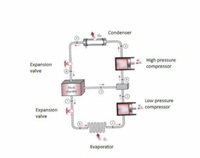
Concept explainers
Consider a two-stage cascade refrigeration cycle with a flash chamber as shown in Figure Q4(b) with refrigerant R-134a as the working fluid. The evaporator temperature is -10oC and the condenser pressure is 1600 kPa. The refrigerant leaves the condenser as a saturated liquid and is throttled to a flash chamber operating at 0.45 MPa. Part of the refrigerant evaporates during the flashing process, and this vapour is mixed with the refrigerant leaving the low-pressure compressor. The mixture is then compressed to the condenser pressure by the high-pressure compressor. The liquid in the flash chamber is throttled to the evaporator pressure and cools the refrigerated space as it vaporizes in the evaporator. The mass flow rate of the refrigerant through the low-pressure compressor is 0.11 kg/s. Assuming the refrigerant leaves the evaporator as a saturated vapor and the isentropic efficiency is 86% for both compressors, determine;
- the mass flow rate of the refrigerant through the high-pressure compressor;
- the rate of refrigeration supplied by the system;
- the COP of this refrigerator; and
- the rate of refrigeration and the COP if this refrigerator operated on a single-stage vapor compression cycle between the same evaporating temperature and condenser pressure with the same compressor efficiency and the same flow rate as calculated in part (i).

Trending nowThis is a popular solution!
Step by stepSolved in 2 steps with 3 images

- Note:hand written solution should be avoided.arrow_forward! Required information Oil flow in a journal bearing can be treated as parallel flow between two large isothermal plates with one plate moving at a constant velocity of 5 m/s and the other stationary. Consider such a flow with a uniform spacing of 0.5 mm between the plates. The temperatures of the upper and lower plates are 40°C and 15°C, respectively. NOTE: This is a multi-part question. Once an answer is submitted, you will be unable to return to this part. Vm/s u(y) The properties of oil at the average temperature of (40+15)/2 = 27.5°C are k = 0.145 W/m-K and μ = 0.605 kg/m-s = 0.605 N-s/m² By simplifying and solving the continuity, momentum, and energy equations, determine the maximum temperature and where it occurs. The maximum temperature is 337.32 °C. The location of the maximum temperature is 0.369 mm above the bottom plate.arrow_forward1. A Rankine cycle with reheating has a throttle pressure of 135 bars at the turbine inlet and 28 bars reheat pressure, the throttle and reheat temperature of the steam is 550C, condenser pressure is 0.035 bar, mass flow rate of steam is 10 kg/sec. Draw the T-s and schematic diagram of the cycle and determine the following: (c) theoretical thermal efficiency (d) the steam rate (e) heat rate of the cyclearrow_forward
- Steam at a pressure of 0.08 bar and a quality of 99.0% enters a shell-and-tube heat exchanger where it condenses on the outside of tubes through which cooling water flows, exiting as saturated liquid at 0.08 bar. The mass flow rate of the condensing steam is 5.8 x 105 kg/h. Cooling water enters the tubes at 15°C and exits at 35°C with negligible change in pressure. Neglecting stray heat transfer and ignoring kinetic and potential energy effects, determine the mass flow rate of the cooling water, in kg/h, for steady-state operation. mwater = i 568765.92 kg/harrow_forwardNeed asaparrow_forwarddbbarrow_forward

 Structural Analysis (10th Edition)Civil EngineeringISBN:9780134610672Author:Russell C. HibbelerPublisher:PEARSON
Structural Analysis (10th Edition)Civil EngineeringISBN:9780134610672Author:Russell C. HibbelerPublisher:PEARSON Principles of Foundation Engineering (MindTap Cou...Civil EngineeringISBN:9781337705028Author:Braja M. Das, Nagaratnam SivakuganPublisher:Cengage Learning
Principles of Foundation Engineering (MindTap Cou...Civil EngineeringISBN:9781337705028Author:Braja M. Das, Nagaratnam SivakuganPublisher:Cengage Learning Fundamentals of Structural AnalysisCivil EngineeringISBN:9780073398006Author:Kenneth M. Leet Emeritus, Chia-Ming Uang, Joel LanningPublisher:McGraw-Hill Education
Fundamentals of Structural AnalysisCivil EngineeringISBN:9780073398006Author:Kenneth M. Leet Emeritus, Chia-Ming Uang, Joel LanningPublisher:McGraw-Hill Education
 Traffic and Highway EngineeringCivil EngineeringISBN:9781305156241Author:Garber, Nicholas J.Publisher:Cengage Learning
Traffic and Highway EngineeringCivil EngineeringISBN:9781305156241Author:Garber, Nicholas J.Publisher:Cengage Learning





